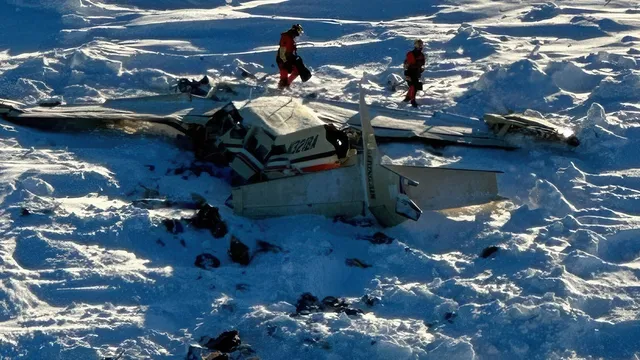
Alaska plane crash was critically overweight, investigation finds
2025-03-20 11:42- The plane was reported missing shortly after taking off from Unalakleet on February 6, 2025.
- Investigators found that the aircraft was significantly overweight at the time of takeoff.
- The ongoing investigation will take over a year to identify probable causes of the crash.
Express your sentiment!
Insights
In February 2025, a tragic plane crash occurred in Alaska, claiming the lives of all 10 people on board. The Bering Air Flight 445 was last tracked shortly after taking off from Unalakleet, heading towards Nome, when contact with air traffic control was lost. Investigations by the National Transportation Safety Board (NTSB) revealed that the aircraft was significantly overweight, with a gross takeoff weight of approximately 9,865 pounds, exceeding the limit for flying in icy conditions by about 1,058 pounds. This fact pointed to potential operational neglect in terms of weight management and safety protocols. The investigation not only examined the weight issue but also scrutinized other crucial factors that could have contributed to the crash, including weather conditions and the effectiveness of the plane's de-icing systems. Just before the crash, air traffic control had indicated that the runway in Nome would be temporarily closed for de-icing. The pilot was advised to adjust their speed and maintain altitude to avoid arriving too early. However, shortly thereafter, the plane encountered trouble, with the autopilot disengaging at a dangerously low speed of 70 knots. The NTSB's findings also highlighted the aircraft's de-icing equipment, centering on an Aircraft Payload Extender that allowed for an increase in maximum gross takeoff weight. Despite this allowance, it was found that the flight was still over the limit for any operations under the APE III flight manual. There was also mention of anti-icing systems that were in place, though it was unclear if their efficacy played a role in the accident. The last satellite data recorded the plane at just 200 feet above the ground, just moments before it disappeared from radar. The pilot, Chad Antill, was described as experienced with about 2,500 flight hours, including substantial time in the Cessna 208B aircraft. Among the victims were various individuals, including workers traveling to Nome for a project related to community services. Following the crash, the bodies of all victims were recovered within days, marking a significant and somber end to the search and rescue operations. In light of the investigation findings, the NTSB is taking a measured approach, emphasizing that determining the exact causes of the crash will take substantial time to ensure comprehensive analysis.
Contexts
The NTSB investigation into the Alaska plane crash aims to identify the factors that contributed to the tragic incident, which occurred in a remote area of Alaska, leading to a significant loss of life. Eyewitness accounts, flight data, weather conditions, and maintenance records will all be crucial in piecing together the timeline of events. Investigators will analyze the flight path and communication logs to understand the pilot's decision-making processes leading up to the crash. Collecting the wreckage and thoroughly examining it will also be vital in determining whether there were mechanical failures or if external factors, such as weather conditions or terrain, played a role in the accident. This comprehensive analysis not only seeks to explain what happened but also aims to provide insights that could prevent future occurrences of similar incidents in this challenging flying environment. The terrain and weather in Alaska present unique challenges for pilots, particularly in the winter months, when harsh conditions can deteriorate rapidly. Investigators will look into whether the crew had sufficient experience flying in such conditions and whether the aircraft was appropriately equipped for the flight. They will also consider whether proper protocols were followed during the pre-flight checks and if the flight path was altered due to unforeseen circumstances. The findings from this investigation could highlight gaps in current aviation safety regulations and training requirements, emphasizing the need for continuous improvements in procedures and equipment for safer airline operations in remote areas. Furthermore, the investigation will involve collaboration with various agencies, including the FAA and local law enforcement. This collaboration is essential for gathering a comprehensive view of the circumstances surrounding the crash. Witness statements from other pilots or nearby residents could provide valuable insights, particularly regarding any unusual activity or conditions observed at the time of the incident. Importantly, the investigation will also consider the psychological and physiological state of the crew on the day of the crash, as human factors can play a critical role in aviation safety, especially in high-pressure situations like flying in challenging environments. The outcome of the NTSB investigation holds significant implications for both the aviation industry and the traveling public. Recommendations arising from the report may lead to policy changes that enhance safety protocols, pilot training, and aircraft design in Alaska and beyond. The hope is that by thoroughly investigating this incident, the NTSB will be able to provide actionable insights that not only clarify the reasons behind this particular crash but also contribute to the overarching goal of reducing aviation accidents through improved safety measures.